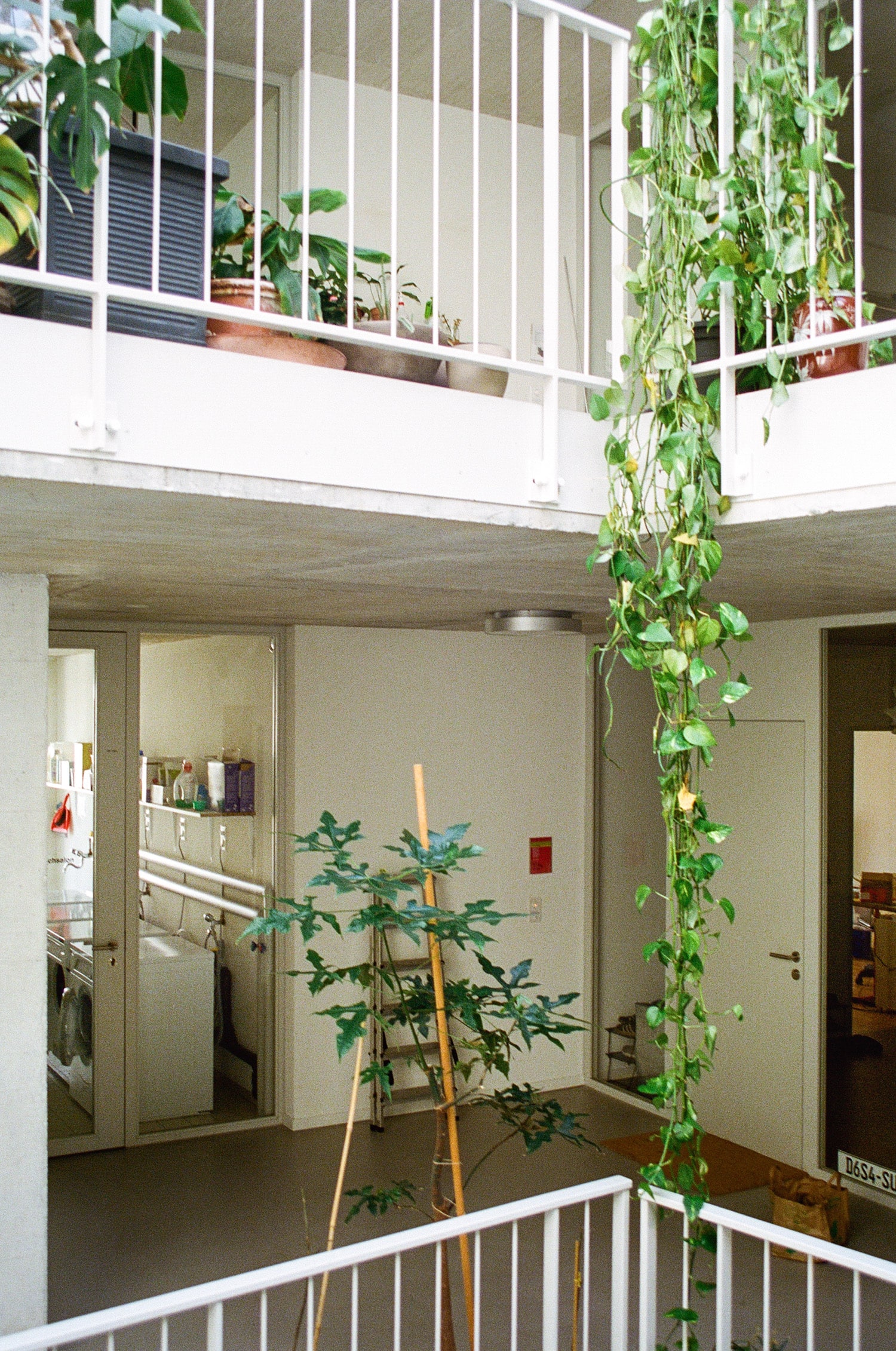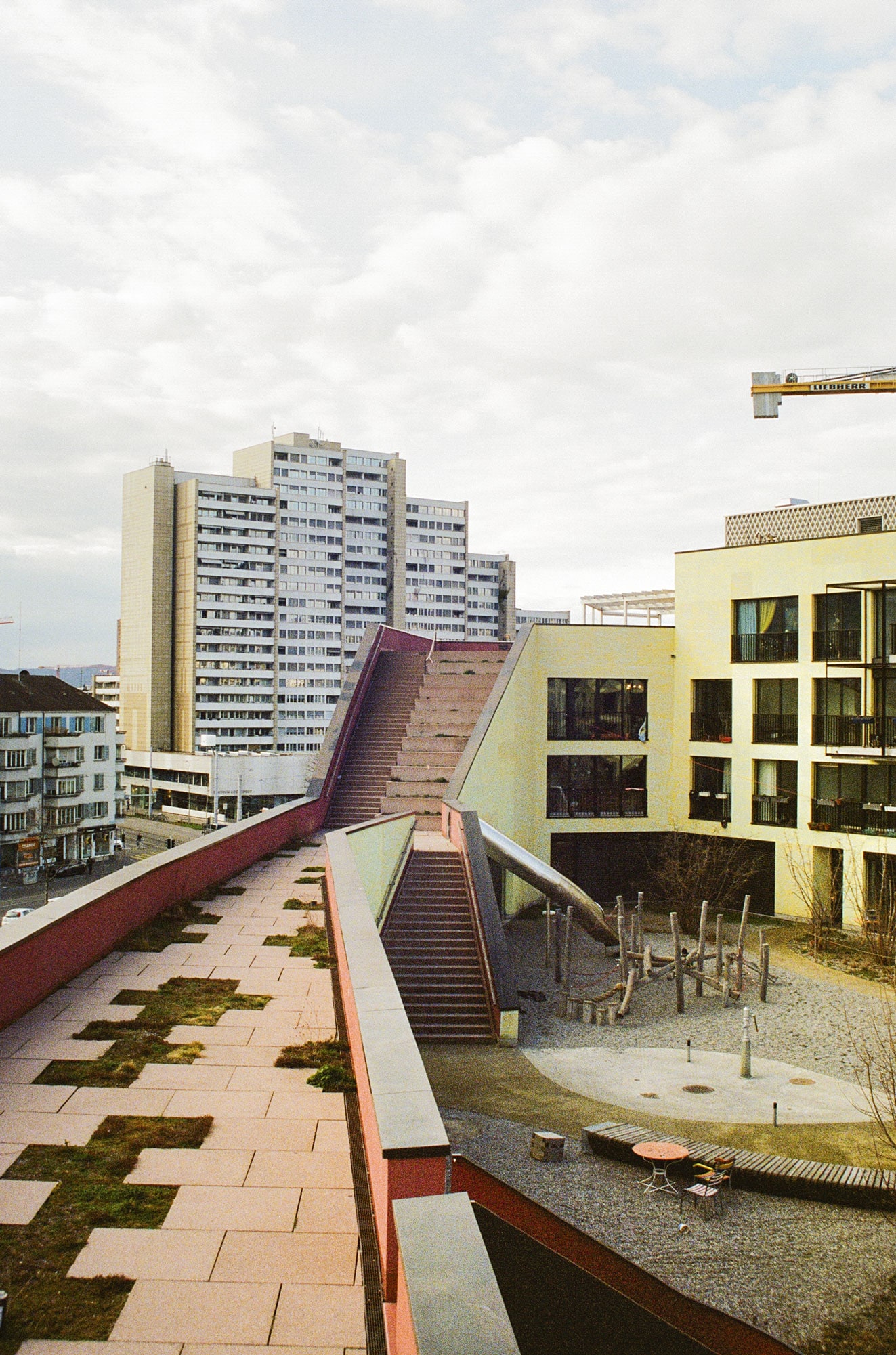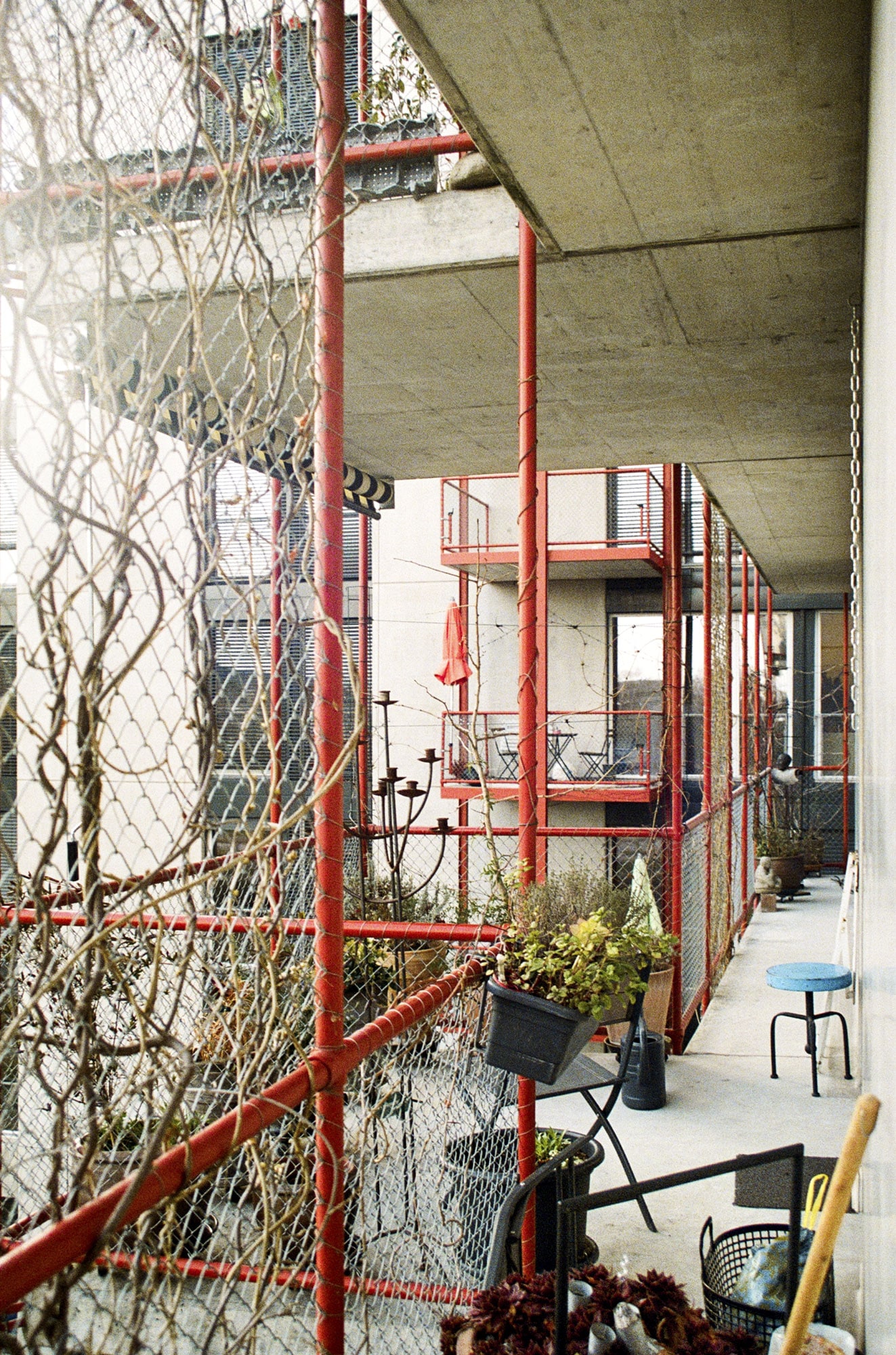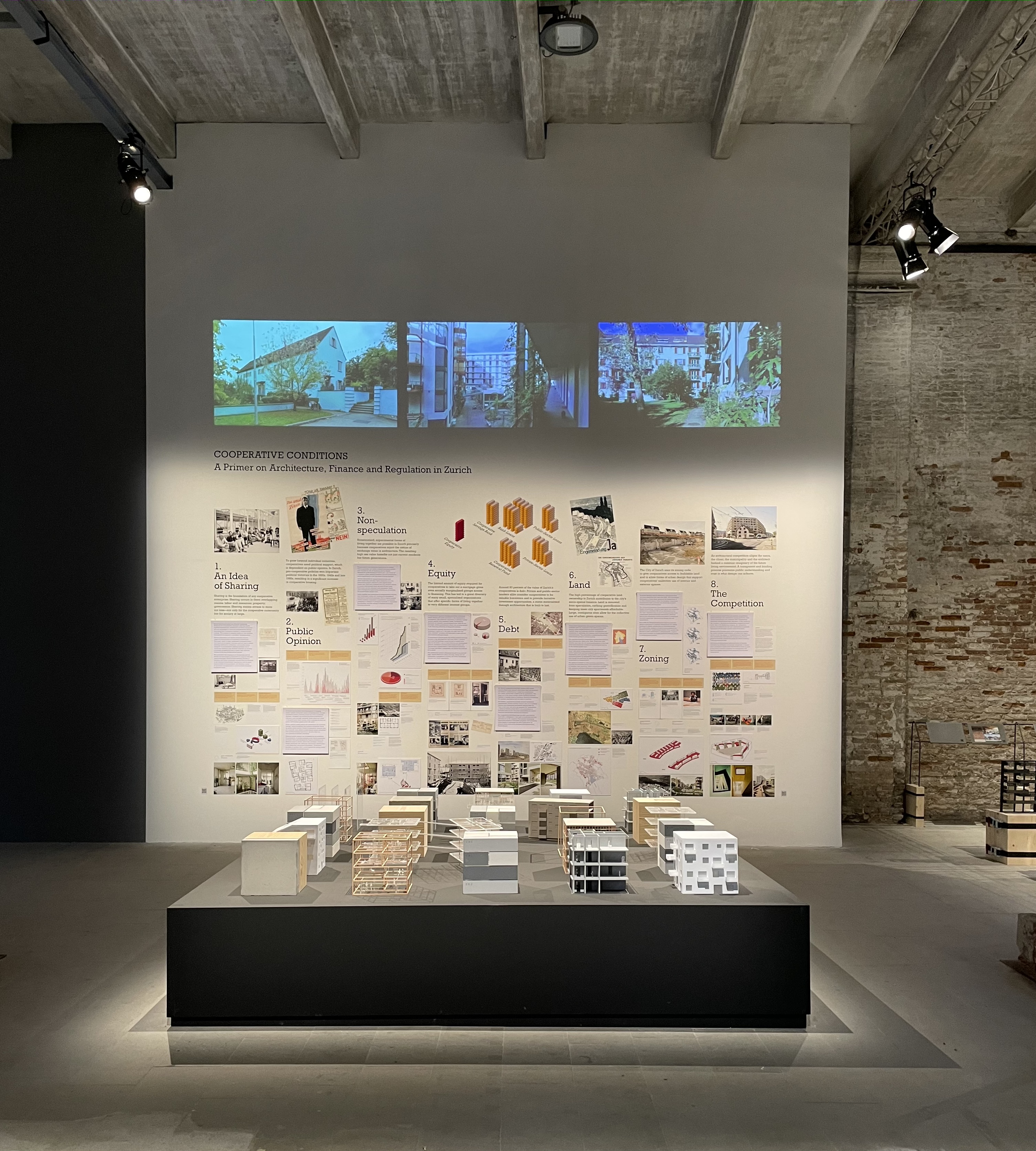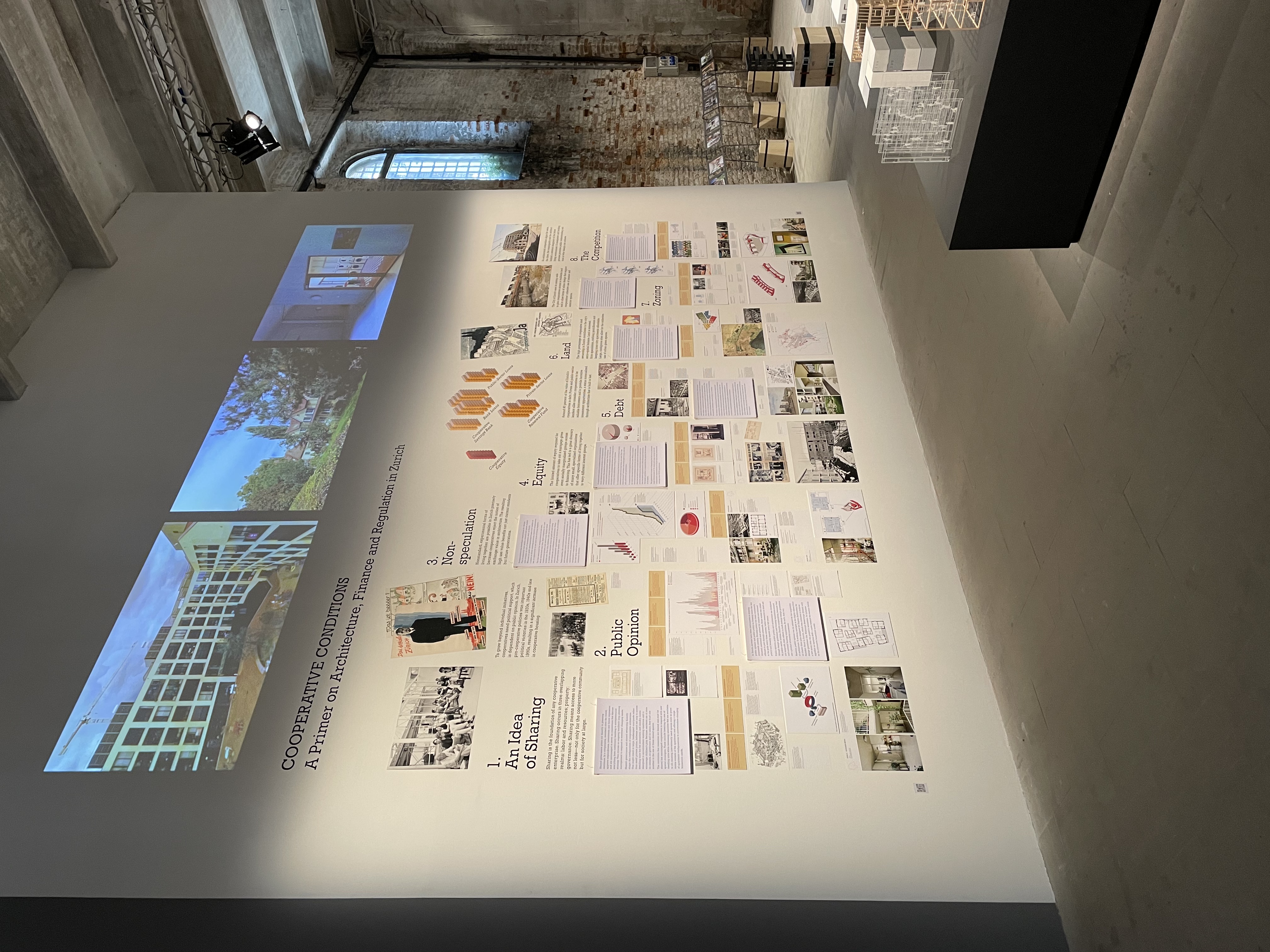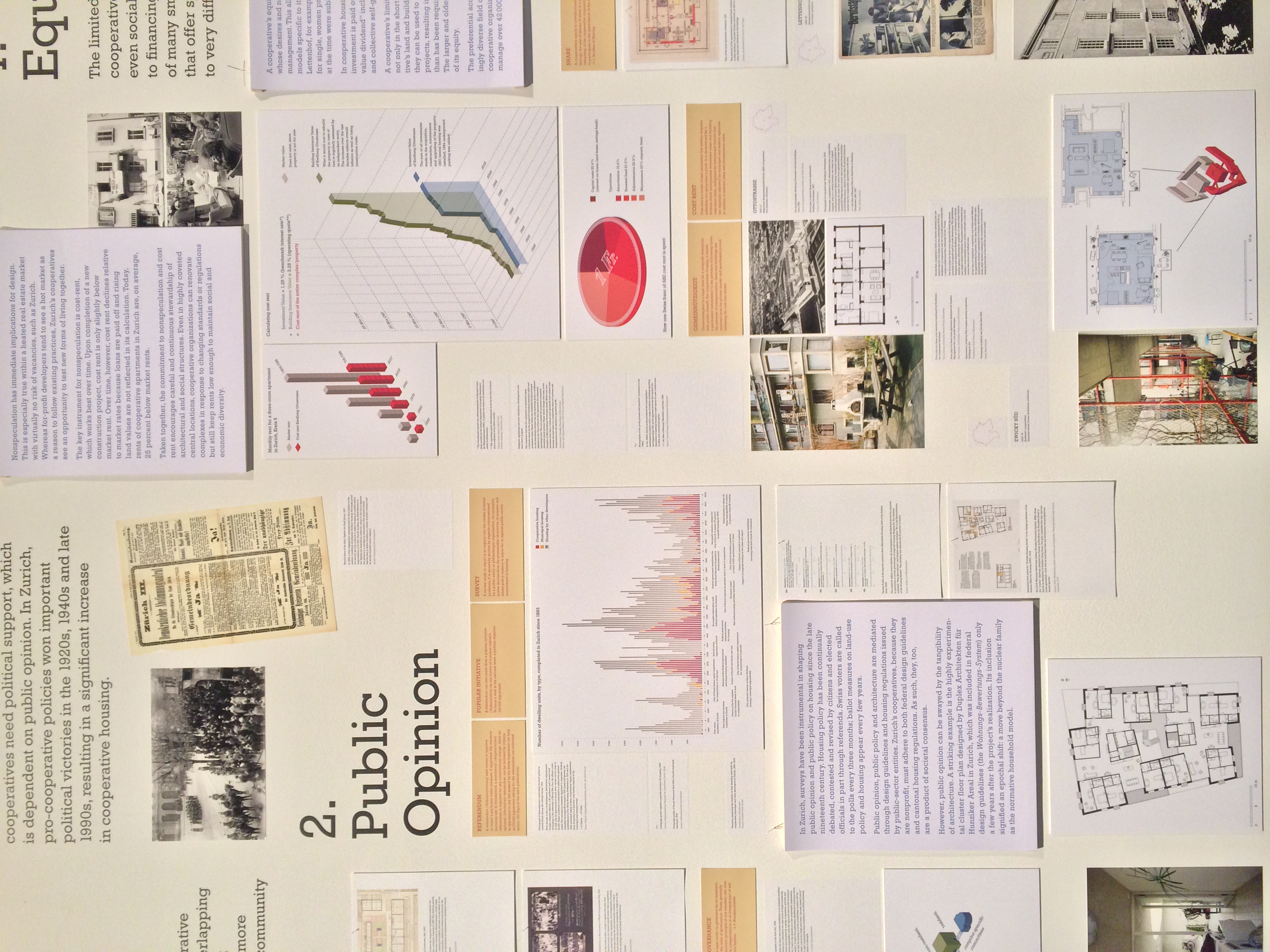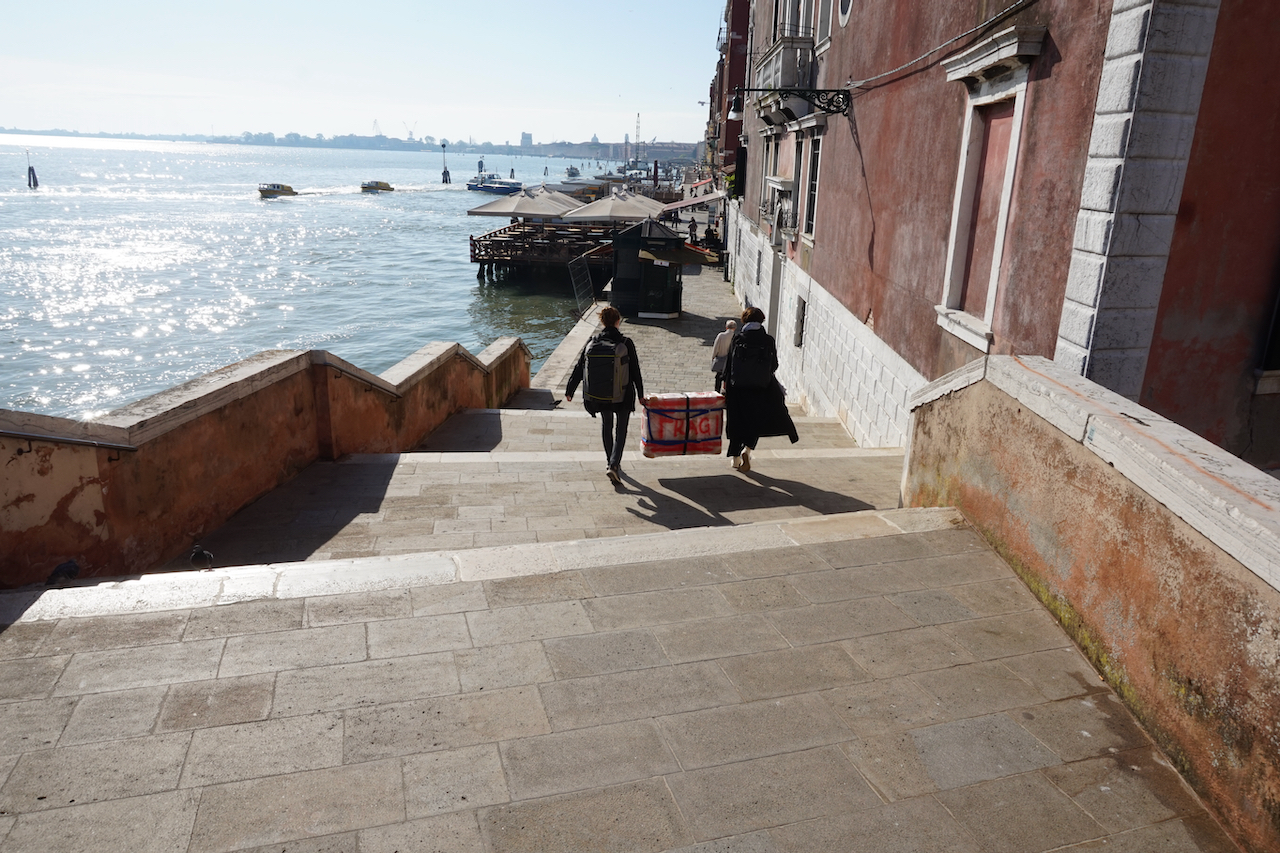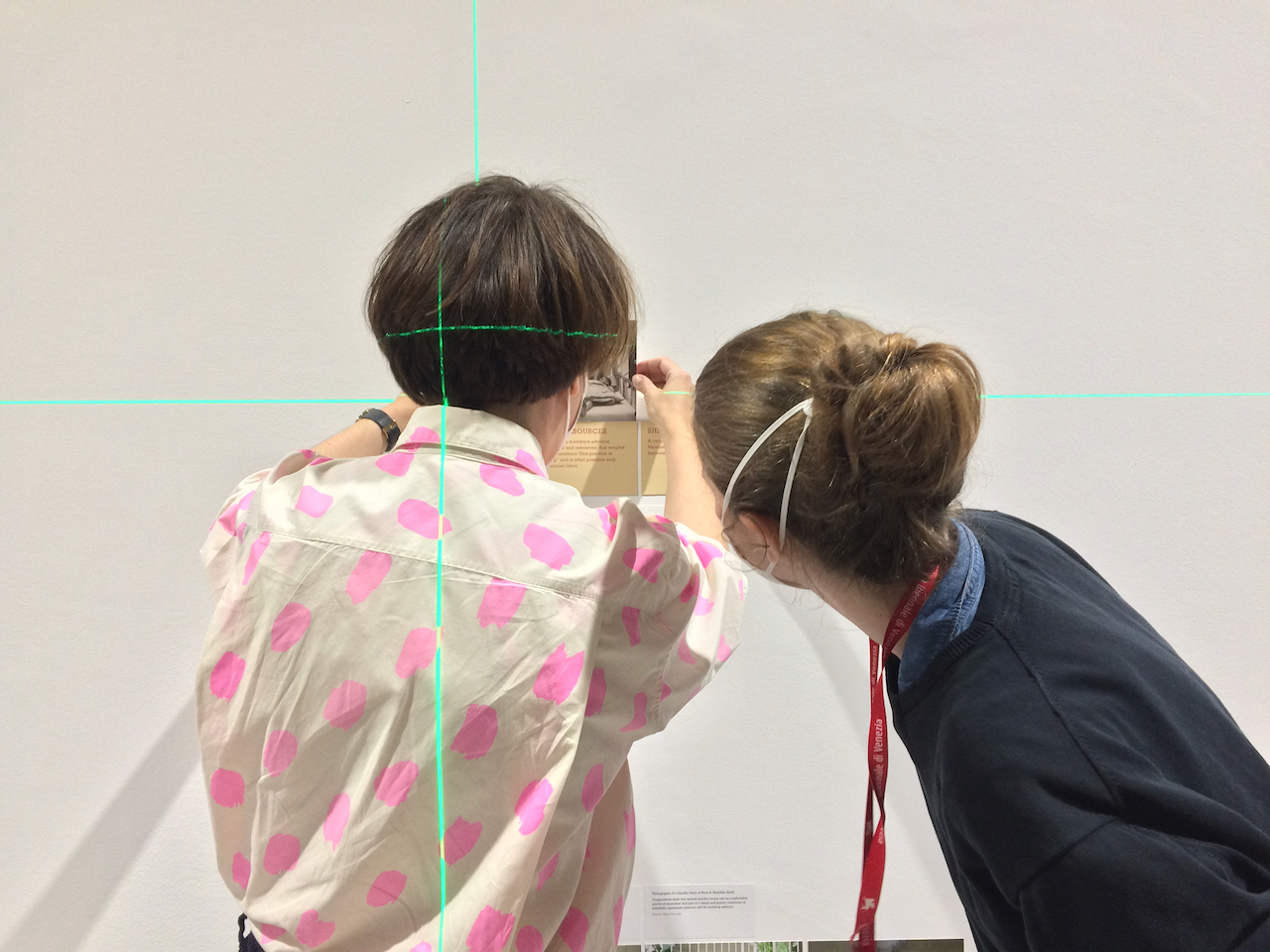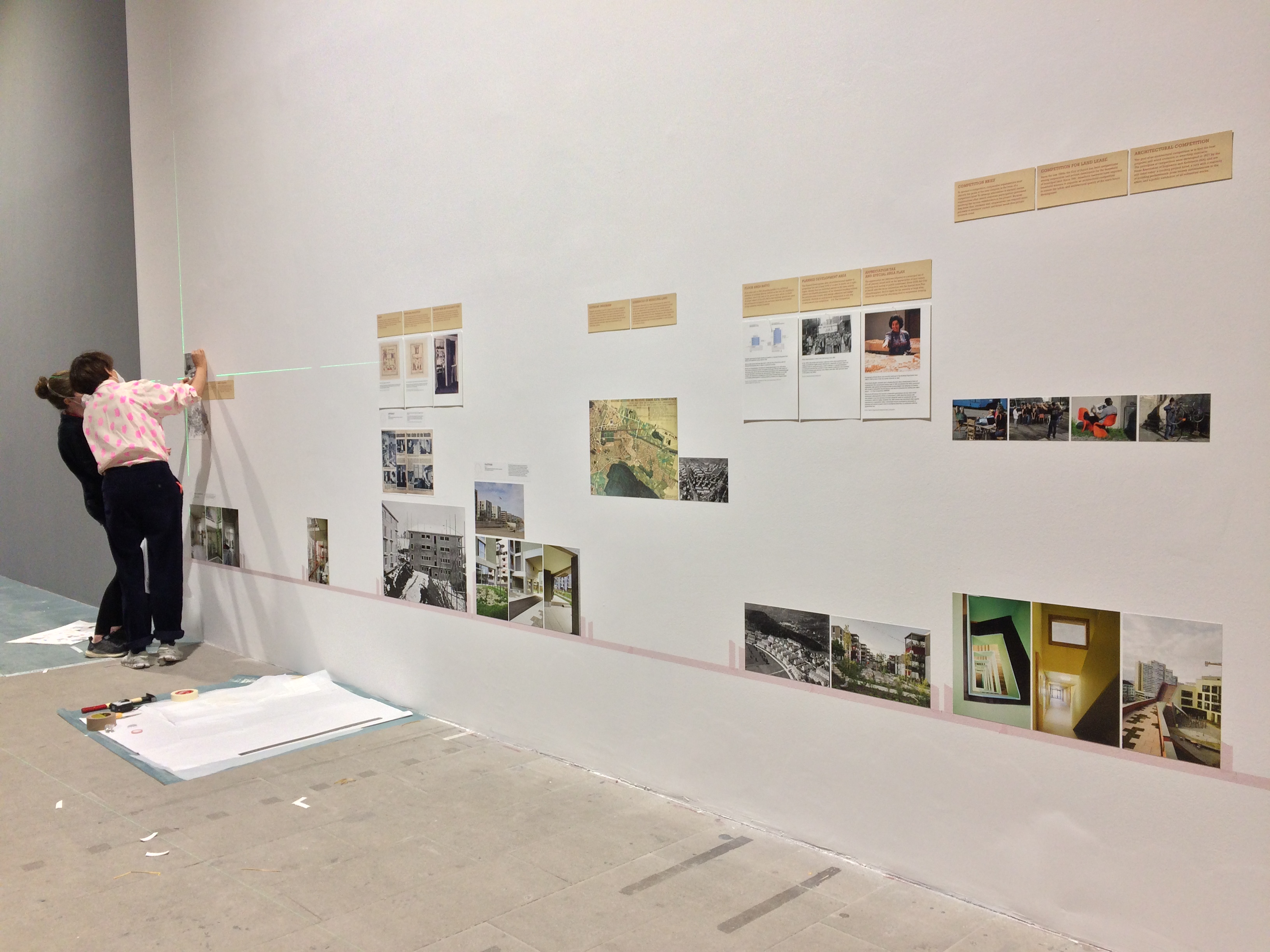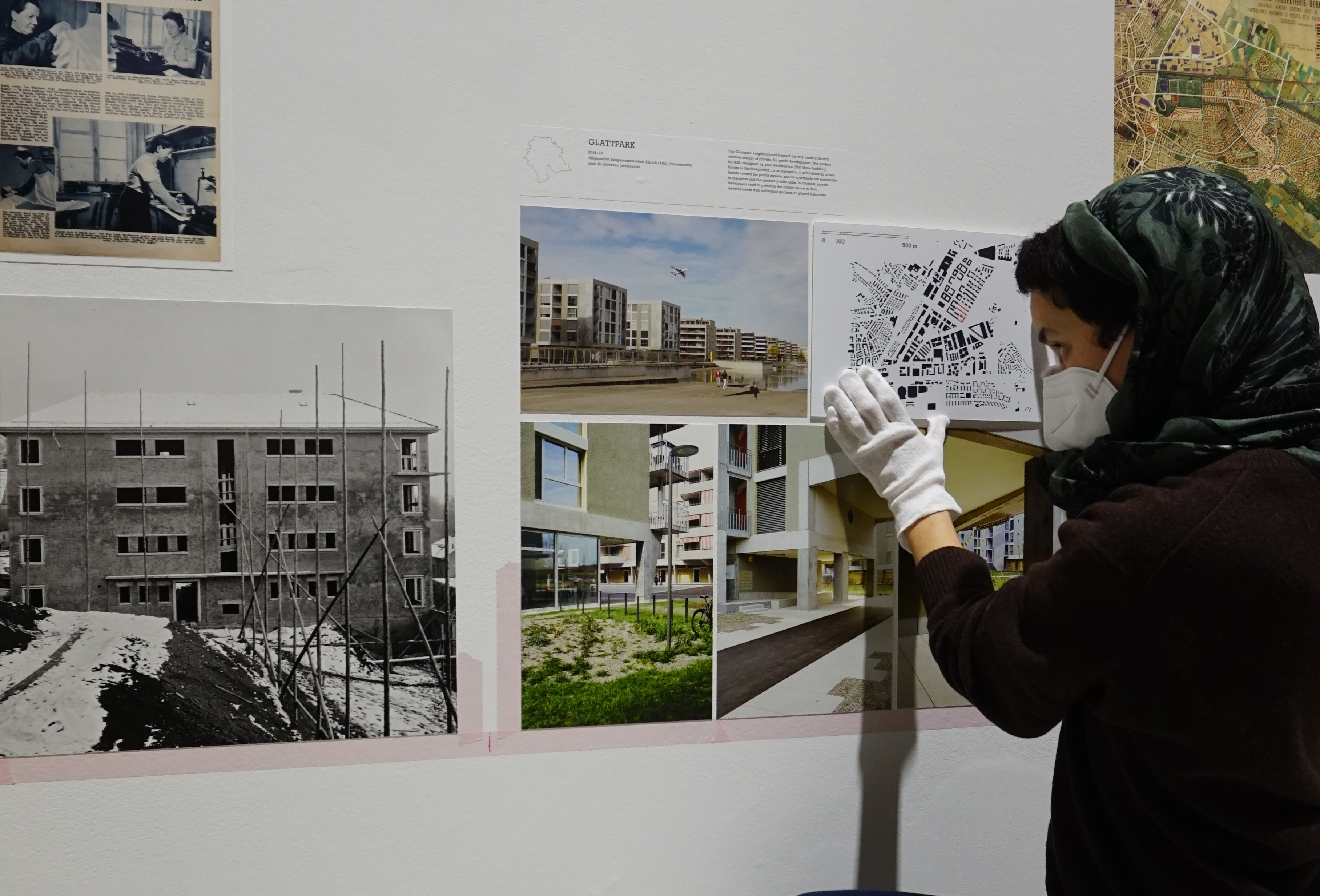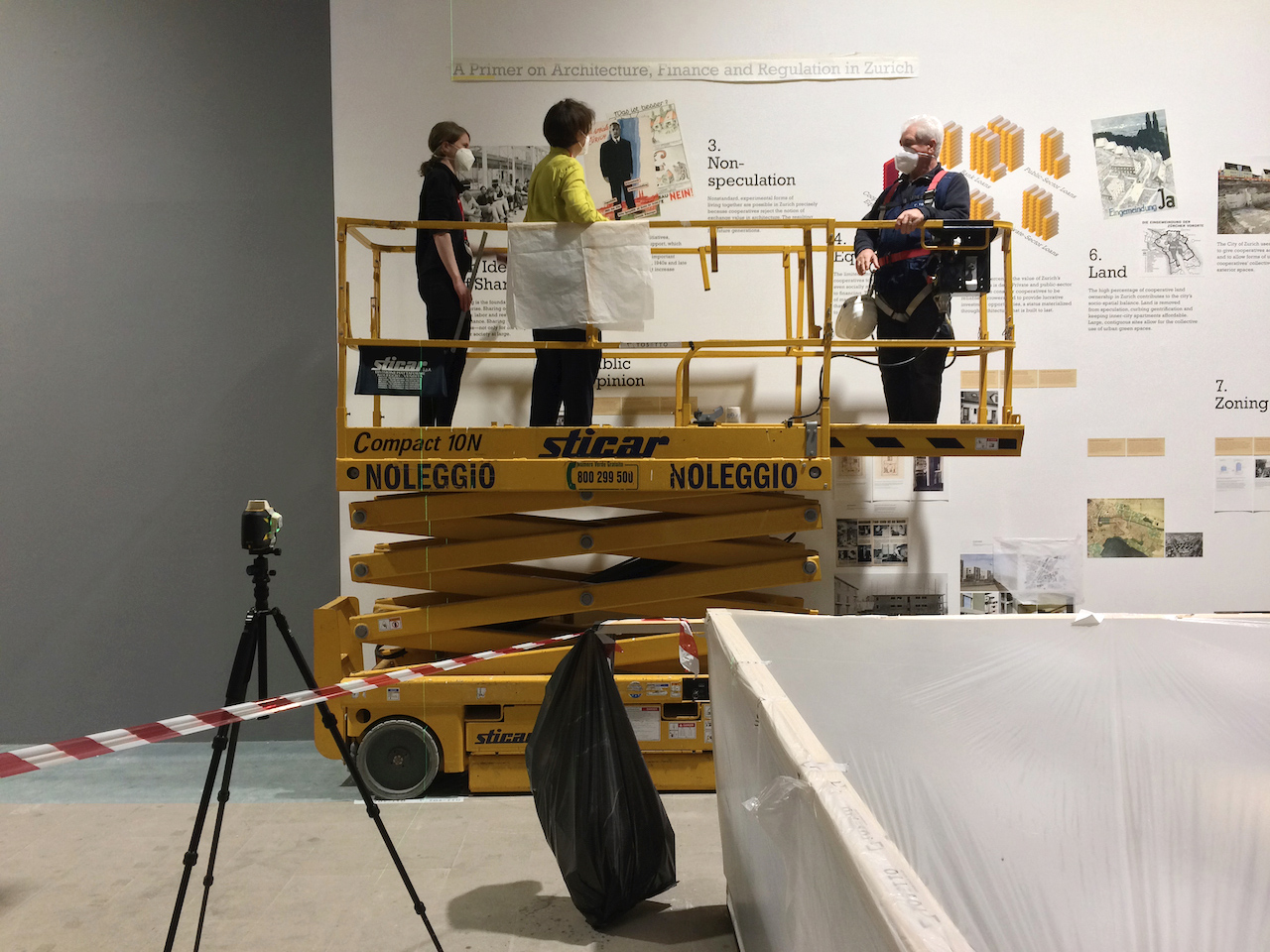Introduction
Housing and the Agency of Nonspeculation
Anne Kockelkorn & Susanne Schindler
1. Appraisal: Housing the Self, the Collective and the City
2. A Taxonomy of Conditions: Instruments, Origins, Agency
3. Insights: Both-And
4. Acknowledgements: A Cooperative Project
Zurich is a center of global finance and exemplifies the associated pressure of a financialized real estate market on housing practices. Rents for new residential leases have risen by more than 60 percent since 2000, property prices have approximately doubled since 2009 and large-scale inner-city developments are today run by globalized financial investors and pension funds.1 At the same time, Switzerland’s largest and historically most industrialized city has not been subject to the same processes of social polarization and gentrification as Berlin or London.2 In fact, Zurich has a century-old tradition of nonprofit housing, a sector that has grown continuously since 1995.3 Today, 25 percent of the city’s dwelling units are permanently withdrawn from the for-profit sector, with the largest share, 18 percent, cooperatively owned and the remainder comprising municipal housing or housing operated by other nonprofit entities.4
What makes the Zurich case so remarkable is not just the sustained commitment to decommodification. Cooperatives founded one hundred years ago offer city-center rents at one-third the market rate, demonstrating the “collective possibility” of architecture and urban design—a powerful conceptual counterpoint to the myth of the autonomous individual.5 In the process of maintaining and expanding Zurich’s noncommodified housing stock, the city’s cooperative movement—activists, city officials, architects, funders—has supported and realized experimental forms of living together that are able to accommodate and incite social change. Emblematic projects of cooperative organizations such as Kraftwerk1, Kalkbreite and mehr als wohnen, realized from 1998 to 2015, cater to a variety of income groups and household formations. They also offer collective spaces of stunning architectural and material quality and contribute to a public realm of which multiple user groups, including the general public, can partake.
Zurich proves that architectural innovation and social entrepreneurship in housing—the simultaneity of social engagement and entrepreneurial action—is possible at scale, even in the age of real estate financialization.6 This striking case prompted us to ask: What enables a long-standing commitment to nonspeculation within a for-profit real estate market? How can Zurich’s cooperative model become transferrable to other places? How does architecture partake in these processes, and how does its partaking expand the definition of architecture?

 1. Appraisal: Housing the Self, the Collective and the City
1. Appraisal: Housing the Self, the Collective and the City
Resonance with the world
To appreciate what Zurich has achieved in one hundred years of nonspeculative housing, we must take stock of the forces that shape how we live today. This concerns in particular the continuous acceleration and multiplication of option imposed by the process of modernization and its antinomy to modernity’s promise of individual self-determination and autonomy. In most Western, industrialized countries, these forces are in tension with one another: individuals often feel torn, driven toward an individualism and entrepreneurial self-responsibility that precludes the collective, while struggling to maintain a sense of the good life to which they feel entitled.
In Society of Singularities (2017), sociologist Andreas Reckwitz observes that the notion of the “collective” is becoming increasingly charged with imaginaries of nationalism, racism and pejorative demarcations of sociocultural “losers.”7 At the same time, Reckwitz describes a broad societal striving (active since the 1970s) among the educated middle classes in the postindustrial societies of Western Europe to attain singularity; that is, the appreciation of a social entity in terms of “inherent complexity and inner density.”8 Today, Reckwitz argues, the individual’s performance of creativity and authenticity is what leads to societal attention and approval, and this striving must transcend anything related to the notion of a standardized mass society.9 But this singularization comes at a price. It pressures individuals to perform constant self-actualization in their professional and private lives, even as society’s accelerating rate of change increasingly limits any one individual’s chances of actually achieving singularization.
Chasing singularity and chasing the resources that seem necessary to achieve it can obscure the very goal that triggered the chase; namely, to live what Hartmut Rosa calls the “good life” based on the experience of a “positive resonance” between the self, others and the environment. Western societies increasingly confound the “good life” with the accumulation of resources—wealth, knowledge, networks, space—instead of defining and delimiting the conditions of positive resonance with the world.10
Reckwitz’s and Rosa’s diagnoses help to explain why cooperatives are of interest: they offer an economic model that counters an otherwise unquestioned drive to maximize resources—including the unlimited appreciation of real estate values. Zurich’s cooperatives are also relevant because they reconcile the societal striving toward the singular with a notion of the collective that defies reactionary imaginaries of “the other.” They answer to the specific housing needs of an increasingly singularized society while offering the possibility of collectively sharing spaces, knowledge and resources at multiple scales of the city.
New Household Formations and Shared Spaces
At the scale of the household, the young cooperatives Kraftwerk1, Kalkbreite and mehr als wohnen have adopted a transitional understanding of “household,” asking who constitutes a social unit and for how long. Their apartment types embrace a patchwork of household configurations, from part-time families to solo dwellers, couples and the traditional “nuclear” family. Dwelling typologies include cluster housing—groups of micro-units assembled into a larger whole—as well as apartments for up to 50 people, sometimes with access to a serviced kitchen. Such exceptional apartment types are then combined with conventional flats to achieve a deliberately choreographed mix within a single development.
Cooperatives also offer a broad range of collectively shared spaces that allow these different household formations to live together. The ability to plan, build and maintain community facilities and shared urban spaces is a key characteristic of both new and old cooperative housing developments in Zurich: this ability evolved over the course of 100 years to compensate for strict occupancy rules (often allowing no more than one extra room per resident per dwelling) and reduced allocations of private space to each resident (one of the means by which cooperatives are able to offer cheaper rents than the for-profit market). “Our dwellings don’t stop at the front door,” says Philipp Klaus, a member of Kraftwerk1’s executive board.11 Shared spaces are therefore central to a cooperative’s mode of functioning, but the new generation of cooperatives has reframed their dimension and role. Kalkbreite, Zwicky Süd and House A at Hunziker Areal impress with light-flooded atrium stairwells, inviting laundry rooms, collective libraries, shared roof terraces and generous entry halls offering sheltered arrival for those pushing prams and carrying shopping bags.
At the scale of the neighborhood, cooperatives are expanding the use of shared space to include not only residents but neighbors and the wider public. This is of paramount importance when attempting to confer urban qualities on new developments in the urban periphery, and this is where the potential political and architectural economy of the cooperative is most relevant for the territorial equilibrium of cities today. Zwicky Süd and Hunziker Areal, both situated in underserved locations, have succeeded in creating urban micro-centralities by bringing small shops and other commercial enterprises to the ground floors of their development. Whereas private developers often refrain from implementing mixed-use in peripheral locations, cooperatives tend to be more successful because they are under less pressure to generate immediate revenue. As Anne Kaestle, principal of Duplex Architekten, master planners of Hunziker Areal, explains, this allows cooperatives to “curate” users and “take more time” to find suitable tenants.12
Other large parcels on Zurich’s outskirts, cooperatives demonstrate a quieter but possibly more important variation of urbanity—one that offers shared experiences of urban spaces beyond those typically provided by commercial developments. In ABZ’s Entlisberg project, for example, balconies filter the private interiors toward landscaped areas that serve both as extensions of the surrounding apartments and as public walkways. These projects are, as Entlisberg’s architect Marius Hug, principal of Meier Hug Architekten, puts it, “machines for collective life” rather than Corbusian machines-for-living geared toward maximizing functional efficiency.13 This architecture offers public access to a shared experience of the urban on sites where such possibilities are anything but a given.
At the scale of the city, cooperative developments keep rents affordable for the lower and middle classes and protect residents’ right to remain for life—if not in a given apartment itself, then at least in the neighborhood. In contrast, residents of private developments generally pay higher rents, and this difference increases over time as the market value of land is figured into the for-profit rents, but not in the cost rent of the cooperative developments.14 The projects of for-profit developers in Zurich also typically do not offer the broad scope of collective facilities and publicly accessible porous urban green spaces that cooperative developments do. Instead, their primary goal is to maximize financial revenue from privatized, marketable space. Urban space is first and foremost considered as a factor that increases the value of apartments and hence is preferably allocated to individual residents or the collective of residents—but not to the city.
These differing priorities become most obvious where cooperatives and for-profit developers have realized different sections of a larger development. At Glattpark, the space between the continuous building blocks of the for-profit developments consists of mowed lawns enclosed by hedges and produced for the gaze from the interior, while glazed balconies project the interior functions of dwelling toward the outside space. In contrast, the project by ABZ and pool Architekten offers publicly accessible walkways across a sequence of porous courtyards, with children’s playgrounds, bike racks and a landscaped public garden, while the receding loggias shelter residents on the upper floors from public view. But the absence of shared spaces in for-profit developments also indicates a knowledge gap: their developers know little about future users’ desires. Maintaining and managing shared facilities exceeds what they are willing and able to do.15
The provision of outstanding material and socio-spatial qualities combined with the guarantee that they will remain exempt from commodification in perpetuity is possible because the Zurich model of cooperative housing privileges the use value of housing over its exchange value, or the commodity aspect of real estate. This notion of use value has been institutionalized in the municipal governance of urban space in Zurich for more than hundred years, and that is precisely what is so remarkable and forward-thinking about this case. Among the many regulatory instruments that allow for the positive resonance of Zurich’s cooperative housing today are privileged access to mortgages and the definition of Gemeinnützigkeit, which roughly translates as “nonprofit notion of the public interest.” These regulatory tools create what is called, in German, Handlungsspielraum, which best translates as “agency” but literally describes the space in which action becomes possible. The German term, by including Spiel, also implies a technical and theatrical notion of play and movement—notions that we think with when we refer to architecture’s agency in enabling a resonance with the world.

 2. A Taxonomy of Conditions: Instruments, Origins, Agency
2. A Taxonomy of Conditions: Instruments, Origins, Agency
As part of our project, we offer a primer comprising eight dossiers—An Idea of Sharing, Public Opinion, Nonspeculation, Equity, Debt, Land, Zoning and The Competition—that systematically relate the regulatory conditions of cooperative housing to its concrete, socio-spatial materialization at the multiple scales of the city. By doing so, we are taking aim at the Handlungsspielraum, or agency of cooperative housing. This endeavor is based on two convictions. First, as architects and historians, we must expand the temporal framework of what constitutes the present and its possibilities for action by looking one hundred years into the past and future. Second, we must expand the understanding of architecture to include the socio-spatial relations that take place within the set of possibilities created by a regulatory framework.
This exercise in transversality and co-temporality builds on a substantial (and continuously increasing) body of scholarship both on cooperative housing in general and on Zurich’s housing cooperatives in particular.16 Exhaustive documentation by the Zurich city government has allowed researchers easy access to relevant data.17 Seminal histories of Zurich’s housing cooperatives allowed us to align with or contest existing interpretations of the past.18 Finally, we also build on a growing body of comparative studies of alternate development models as well as recent studies in the field of housing governmentality.19 In addition to this scholarship, Zurich’s cooperatives have become well known through exhibitions, magazines, journals and trade publications, as well as the cooperative organizations themselves, which actively encourage tours of their projects.20
We expand this immense body of literature and the cooperatives’ own marketization efforts by situating cooperatives within financial systems, by showing how histories transform the future and by expanding understandings of architecture as built form. The goal of this approach is to counter an assumption, widely held in schools of architecture, that matters of architecture, finance and regulation are not, and should not be, part of the same field. Often, such arguments emerge from a fear of diminished disciplinary standing, as if economic literacy would undermine one’s credibility as a designer. Our approach also counters the separation between design courses and history and theory—not because history and theory should serve design in terms of the what or how but because they should empower designers to ask why.
Conditions and Instruments
To answer our project’s first question—What enables a commitment to nonspeculation within a for-profit real estate market?—we identified eight conditions that are essential to the emergence of cooperative housing in Zurich and its socio-spatial qualities. Each is elaborated in a website dossier that sets architectural form, social space, territorial regulation and the political economy of nonspeculation in relation to one another. For example, the first condition, An Idea of Sharing, not only impacts joint ownership and collective decision-making but also the disposition and use of shared spaces. The second condition, Public Opinion, is essential both for political support and the normalization of architectural typologies. The fourth and fifth conditions—Equity and Debt—relate cooperatives’ financial constructs to their organizational and architectural diversity. The conditions Land, Zoning and The Competition analyze how regulations pertaining to land-use and process, under the premise of nonspeculation, foster architectural and urban-design innovation. The key condition of our investigation—Nonspeculation—thus sits squarely between the regulatory, financial and spatial repercussions of the political economy of cooperative housing.
To get at the regulatory mechanics of these conditions, each dossier investigates two or three instruments of “territorial regulation” that describe the legal and societal framework of urban development through norms, rules, laws, conventions and other institutional relationships.21 The instruments answer fundamental questions at both the abstract and the concrete levels of government, such as the concept of Gemeinnützigkeit and “cost rent”. Instruments in other dossiers refer to concepts and practices that have become so naturalized that many practitioners rarely pause to question them; for instance, owning land or owing money. Some tools, such as “municipal rulings” or “the share” of a cooperative’s property are familiar to housing professionals but rarely investigated as triggers of urban design and architectural form. In turn, instruments well-known to architects and planners, such as zoning laws or competitions for land leases, explain how the abstract idea of sharing can be translated into concrete form.
Historic Origins and an Expanded Time Frame
To answer our second question—How can Zurich’s cooperative model become transferrable to other places?—we investigated the historic origins of conditions and instruments and considered them within an expanded time frame.
By focusing on the moment of emergence of a particular law or practice—how much equity is required to take out a loan or the way in which an architectural competition is organized—we can understand why a law or practice gained enough political support to become a reality. To whom and toward what end did it seem desirable? The social, economic and legal aspects of regulation are societal constructs: both negotiable and specific to a particular time and place. Thus, in seeking to make instruments transferable, one ought to focus not on transferring a law or practice from one place to another as is but on understanding the perceived promise of that law or practice at a particular moment in time.
To understand the relevance of such instruments today requires that they be considered within a longer-term historic continuity. Extending the time frame of analysis is particularly important for nonspeculative housing since its benefits, like low rent, accrue across time. And expanding the time frame is important not only for scholars who wish to study these effects. Crucially, practitioners must also consider the impact of their work not only in the five- to ten-year horizon that extends from idea to implementation but in a time frame that extends one hundred years into the past and one hundred into the future. An awareness of preceding generations’ struggles with similar challenges and how they responded can open new perspectives onto the how and why of one’s work. Similarly, reflecting on what present-day actions might mean one hundred years from now can productively reframe a design project. The point is to ask, with anthropologist Amanda Huron, how the benefits of the present extend beyond current beneficiaries toward “as yet unknown” future generations.22
Such an expanded conceptualization of the present also allows us to resituate Zurich’s achievements in the context of Switzerland’s atypically high standard of living and political stability. This small, landlocked countryhas enjoyed remarkable longevity and thus trust in its institutions, disrupted neither by wars nor major social upheavals. Several circumstances have favored the emergence of cooperative practices: the political system is organized from the local to the national, and the sharing of limited natural resources has long been habitual. These aspects are hardly replicable. What can be transferred to other places, however, are the ways in which activists, citizens, elected officials, cooperative organizations and architects use legal, financial and regulatory instruments, as well as the architectural imagination, to advance a nonspeculative form of housing development and new forms of living together. The instruments we describe can be negotiated within the specific political struggles of other locales and will play out in a similar manner when deployed over time.
Agency and Handlungsspielraum
A response to the third guiding question of this project—How does architecture partake in these processes, and how does its partaking expand the definition of architecture?—becomes possible only through consideration of regulatory constructs, their historic origins and their long-standing impact on the built environment. The process of relating instruments and historic origins within a layered, condensed, yet expanded notion of time opens up architectural agency in a twofold way. The first is the agency of architects, planners and citizens to shape the built environment, to mediate social relations of living together and to bring about change through a range of strategies: it is the space in which action becomes possible, the Handlungsspielraum.23 The second notion of architectural agency refers to the effect of form itself, its Wirksamkeit. We argue that the use value of housing and the accessibility of desirable forms of living is not a matter of form alone, but a process that is directly tied to a regulatory framework and its ensuing urbanization processes.24 Hence, the agency of form is something that takes place in resonance with situated variations of use, the processes by which users’ selves are socially conditioned (i.e., subjectivation) and the ways territories and subjects are governed.25
The floor plans for Zwicky Süd (2015), developed by a cooperative and two for-profit developers, exemplify how architectural agency involves such processes of subjectivation within a regulatory framework. Kraftwerk1, the cooperative developer, emphasized gallery access to its apartments and flexible, dividable floor plans, allowing residents to adapt their living environment as needed and encouraging spontaneous encounters among residents. The private developers, in contrast, prioritized point access and apartments with fixed, separate rooms, thus minimizing opportunities for encounters with neighbors and emphasizing privacy even within the apartment. However, it is not only the architectural disposition of dwelling unit and the distribution of a building that mediate different types of subjectivity, but also their mode of operation and their situatedness within the city. Over time, rents in the cooperative development will decrease while rents in the for-profit development will increase; and paradoxically enough, it is the mixed-use offer in the cooperative development that guarantees the attractivity of this otherwise peripheral site. The architecture of Zwicky-Süd, as form, partakes in this partly territorial, managerial and regulatory process—and this partaking expands our definition of architecture as form.
If the stunning shared spaces and experimental floor plans of cooperative housing in Zurich reveal how material form can positively resonate with the lived spaces of its inhabitants, the Zurich case also shows that material form can even give rise to a feedback loop that impacts the regulatory framework. In the 1920s, for example, a push to adopt the garden city as an urban model led to a revision of building laws and would shape Zurich’s first zoning code, adopted in 1946. Nearly one hundred years later, the Federal Office of Housing WBO chose the “cluster” typology created by Duplex Architekten for mehr als wohnen’s House A in Hunziker Areal of 2015, for its design guidelines as exemplary of flexible living forms. However, we argue that architecture can sustain a positive resonance for the practice of dwelling only if society agrees about the purpose and public benefit of the use value of dwelling. If public opinion does not support a commitment to nonspeculation and use value in housing, architectural form alone will have little chance to mediate the social relations of living together and confer a positive resonance with the self, the collective and the city. In this situation, architects, planners and citizens will have to exclusively recur to the first modality of architectural agency and redesign the regulatory framework itself.

 3. Insights: Both-And
3. Insights: Both-And
Our effort to understand how social entrepreneurialism and architectural innovation come together in Zurich in an era of financialized real estate led to three key insights about how cooperatives have bridged seemingly contradictory realms in redefining certain widely held assumptions about the politics of housing.
Affordability Redefined: The Architectural Leverage of Nonspeculation
The first insight distilled from our investigation is that Zurich’s cooperatives have been able to produce experimental architecture precisely because of, not despite their commitment to, nonspeculation and affordability.
Low-rent housing is often conflated with housing of low quality; that is, built with lower-grade materials and featuring standardized apartment layouts. In Zurich’s cooperatives, the opposite is true. Precisely by renting their apartments at below-market rates, cooperatives minimize the risk of vacancy. Precisely because they are not forced to generate returns on investments, they have the leeway to test new forms of living together. For example, conceiving of, realizing and finding residents for the thirteen-room penthouse apartment at Zwicky Süd was possible because Kraftwerk1 was not under pressure to immediately generate revenue for a form of dwelling that the cooperative wanted to launch and test.26
Understanding nonspeculation as a condition for design innovation thus challenges the widely held assumption that the best way to achieve low rents is through design. Architectural strategies that have been tested for over a century with this belief in mind include the repetition of standardized elements, prefabrication, and limited floor area. While these strategies can contribute to lowering construction costs and decreasing a building’s carbon footprint, passing on the savings from such architectural decisions to the user happens only if there is a commitment to doing so. Cooperatives, too, reduce apartment sizes and experiment with construction methods,27 and these strategies do effect rents; in this case, however, rents tend to fall over time because of the cost-rent model, which is tied to investment costs and removes the main contributor to housing prices—rising land values.
Understanding nonspeculation as a condition for high-quality architecture also inverts the neoliberal paradigm which posits that housing built for lower-income groups, assumed to be subsidized, should be of lower architectural quality lest it become desirable for higher-income groups.28 This neoliberal critique has never quite applied to Zurich’s cooperatives since they are not technically subsidized and have never served only low-income households.29 At the same time, cooperatives have proven these neoliberal critics right: they have pioneered forms of living together that the private market has copied for higher-income clienteles. For example, “cluster apartments” combining several minimal, single-person dwellings around a large, shared kitchen were first tested by cooperatives but have become mainstream among for-profit residential developers.30
The criticism waged at cooperatives most often both from the political left and the political right is that cooperatives are primarily a middle-class proposition and are thus exclusive: residents must have some savings to afford a share in the cooperative, and rents are not pegged to income but result from the cost-rent model and thus often exceed low-income residents’ financial abilities, especially in the case of new construction. Over the life of a property, however, rents tend to decrease, sometimes in absolute terms and always in relation to market rates. Access to cooperative housing thus widens over time.31
Zurich’s cooperatives have thus redefined “affordability” by demonstrating that it is a precondition for design exploration while at the same time showing that residents’ incomes are not a precondition for enjoying its advantages. Zurich’s cooperatives illuminate a way out of a bind often faced by potential residents: the choice between “social housing,” where access is restricted by income and availability, and “market-rate housing,” where access is restricted by ever-rising costs.32 In contrast to both, Zurich’s cooperatives leverage nonspeculation and architecture in equal parts to achieve the goal of at-cost housing open to all.
The Commons Resituated; or, Cooperatives Operate at Once beyond and within the Market
A second key insight to emerge from our study of Zurich’s cooperatives is that these entities, exemplars of the practice of urban commoning, have become actors not only in opposition to but in concert with capitalism.33
In the context of today’s low, even negative interest rates, high land values, and de minimis vacancy rates, cooperatives have become more than reliable borrowers; they have become highly coveted. Private banks, institutions and even individual investors today compete with the Zurich Cantonal Bank (ZKB) to sell mortgages.34 What determines the creditworthiness of a nonprofit entity is the value of its cooperative land. Even if that land technically cannot be sold at market rates, it serves as collateral for various types of long- and short-term loans.35 This has led to an astonishing situation: the balance sheet of Zurich’s largest cooperative, ABZ, shows 30 million Swiss francs in equity and 1.05 billion Swiss francs in debt.36 In mid-2020, ABZ was rated by an accredited institution as being on par if not higher-performing and more secure than Switzerland’s largest publicly traded real estate companies.37 Zurich’s cooperatives thus prove that low-rent housing can be produced and operated in financially lucrative ways, requiring neither extensive state subsidies nor later bailouts.38
But the architectural and urban qualities of cooperative developments are precisely where the tension and contradictions between a commitment to nonspeculation and the logic of entrepreneurship become tangible. The current rush by many cooperatives to demolish and replace functional, well-maintained buildings has to do with a lack of buildable land and the political mandate to densify within city limits. Fueling this rush is less residents’ dissatisfaction with their living environments and more the ready availability of capital.39 Increasingly, such projects have involved centrally located developments noted as historically significant, such as the FGZ’s Friesenberg row houses from the 1920s or ABZ’s Kanzlei perimeter block from the 1930s.40 In the process, cooperatives often seem to undermine their own goals, since the newly built, larger apartments have higher rents than the ones they replaced, and increased apartment size has led to the actual number of apartments increasing only minimally.41
The name of this practice is Ersatzneubau, literally “replacement through new construction.” Cooperatives are under increasing pressure to contribute to the municipal and federal mandates to increase density within built-up areas as part of an effort to combat sprawl and climate change. Arguments made by cooperatives in favor of Ersatzneubau are that the practice is necessary to meet current lifestyle standards relating to the size and configuration of apartments and to comply with new regulations, in particular those related to accessibility and energy efficiency. Redevelopment has been incentivized by revisions to the city’s zoning code allowing for higher density on large, contiguous sites through the tool of the Arealüberbauung, or Planned Development Area. In this way, in areas otherwise zoned for three-story buildings on individual parcels, seven-story structures are permissible on large sites. While citizens and preservationists are increasingly contesting the practice of Ersatzneubau, it has also enabled sensitive, phased renewal intended to keep residents in place, as in BGZ’s work in Schwamendingen.42
Cooperatives’ current redevelopment practices, while controversial, bespeak a commitment to and investment in a nonspeculative future.43 Across their more than one-hundred-year history, not a single cooperative complex has ever “opted out” of its commitment to nonspeculation. In theory, a two-thirds majority of members could, once all public funding has been paid back and pending approval of the municipality, vote to recommodify the housing. But as ABZ CEO Hans Rupp observes, the nonprofit nature is deeply “written into the DNA” of Zurich’s cooperatives.44 Nevertheless, debates continue. Cooperative leaders are well aware that upgrading neighborhoods or spearheading the development of new ones, as Kraftwerk1 did at Zwicky Süd, can increase the valuation of real estate and lead to gentrification even if the new cooperative apartments are rented at cost.45
Autonomy Re-embedded: Private Development Backed by the State
The third key insight from our research is a recognition that the sustained growth of cooperatives across the last century in Zurich was possible only because of their embeddedness with Zurich’s municipal government.46
Cooperatives have crafted an image (and self-image) of themselves as autonomous actors creating alternatives to those offered by the market and as doing so independently of the state. Various aspects of their functioning support this image, including self-determination (they select their own members and draft their own bylaws); self-governance (including all aspects of managing, planning and organizing the life of the cooperative); and economic self-sufficiency (as required by cost rent). A sense of being separate and independent has also been a distinct feature of cooperative architecture and urbanism. That is, for much of their history cooperatives have chosen to materialize as distinct entities in the city, both at the scale of the Siedlung and in terms of a uniform architectural expression across individual buildings.47
Autonomy is also what has made this model of nonprofit housing politically acceptable from left to right and across shifting political trends, as housing scholar Julie Lawson notes.48 Geographers Ivo Balmer and Jean-David Gerber explain the continued growth of the model this way: “Housing cooperatives owe their success to the fact that, despite decommodification, they do not lead to an expansion of state control. To a large extent, housing cooperatives are a private, self-organized solution to a public problem.”49 Nonetheless, even Lawson and Balmer and Gerber go into great detail to explain that continued political and financial support for at-cost housing has been possible only because of the close connections of cooperatives to the workings of municipal governments, as well as initiatives and pressure from organized citizens. Zurich’s cooperatives thus strike an unusual balance: Their claim to autonomy from the state ensures them state support.
Across the last century, this embedded autonomy has led to various forms of state support, the two most significant of which are preferential access to municipal land and preferential access to financing. In 1902, the Canton of Zurich obliged the Zurich Cantonal Bank (ZKB) to lend to cooperatives. In 1910 the required equity was lowered to 10 percent of development costs; in 1924 it was further lowered to 6 percent, where it has remained to this day, enabling cooperatives to obtain mortgages at conventional interest rates but with less than one-third of the equity required of other borrowers. This, in turn, has allowed cooperatives and policymakers to argue that cooperatives are self-sufficient entities that, despite enjoying preferential access to land and financing, should not be considered subsidized. Not technically being subsidized means, in turn, that residents are not subject to income restrictions, which in turn reinforces the sense of cooperatives as autonomous, self-governed communities. All in all, the preferential access to financing has led to an outstandingly diverse field of 141 cooperative organizations in Zurich that today collectively manage over 42 000 apartments—a remarkable realization of collective self-determination and social entrepreneurship that reconciles the strive for individual singularization with the collective.
This embedded autonomy is the result of a continual push and pull between activists and citizens on the one hand and city officials on the other. The Kalkbreite cooperative, a mixed-use development realized on centrally located, municipal land, is a primary example of the effectiveness of a citizen-led campaign to convince the City of Zurich to rededicate a municipal site formerly considered unsuitable for residential use and grant it to a cooperative through a leasehold. The open architectural competition for this project, however, was the result of a municipal policy crafted within city government. In the early 1990s, the city prioritized new residential construction for families and coupled this with requirements for higher-quality designs and transparent selection processes.
Together, these three key insights challenge some of the most persistent assumptions held by architects, planners, scholars, the general public and policymakers about housing—assumptions often framed as mutually exclusive dichotomies rather than as examples of “both-and.” The affordability of housing is the result of nonspeculation and can never be achieved by design alone. The interplay of a nonprofit mission in housing and a profit-driven financial market is real. And even independent, private actors depend on the regulatory powers of the state to flourish. Together, these three insights help to explain what makes social entrepreneurship and architectural experimentation possible in Zurich even during an age when striving for singularities may be limiting our idea of the good life.

 4. Acknowledgements: A Cooperative Project
4. Acknowledgements: A Cooperative Project
Cooperative Conditions was developed with seventeen students in the Master of Advanced Studies Program in the History and Theory of Architecture (MAS gta) at ETH Zurich in the spring of 2020. A joint research project is an integral part of the curriculum of this part-time, post-professional, two-year course; students contribute to a given topic with the goal of producing a publication, exhibition or other public format.
When we began, we had already defined the eight conditions we would explore. We had also determined that students would conduct interviews, engage in archival research and synthesize the findings using an analytical framework organized around Instruments, Historic Origin and Agency. The interviews were most revealing with respect to the relationship of architecture, finance and regulation. We spoke not just with architects and city officials, typically eager to share their views on design and policy, but with the chief executives of cooperative organizations, pension fund managers and bankers. The latter conversations provided insight into the financial dimensions of architectural decisions that even these decision-makers themselves had rarely considered.
The direction and outcome of the research, however, evolved through a continual back and forth among students and instructors. This included the choice of Instruments and the selection of projects to best highlight Agency. Students often took the initiative. They expanded the range of projects to consider and people to interview, and Rebekka Hirschberg proposed film as the best medium to capture the projects’ atmospheres.
In translating the research into graphic form, the feedback and art directorship of Berlin-based graphic studio Monobloque were critical. First Dorothée Billard, then also Clara Neumann, gave shape to aspects of cooperatives that are often discussed but rarely made tangible. Key visualizations include how cost rent develops over time and the relation of equity to various forms of debt.
For the exhibition and this web page, we developed a combined framework to bring together short texts, original graphics and contemporary and historical images. The inextricability of courtyard configurations, interest rates and municipal rulings becomes apparent through the juxtaposition of different artifacts. Visitors will thus find, side by side, a Twitter feed charting the results of a 2020 referendum on housing, an album page commemorating the 1931 World Cooperative Day and contemporary photographs (taken by students) of cooperative spaces.
The website captures a work in progress, at a half-way point between exhibition and book.
Cooperative Conditions, then, is a product of minds working in cooperation to create a primer on architecture, finance and regulation. It was made possible by the many individuals and organizations who contributed knowledge, time, humor and, not least, money. They did so out of a sense that the potential and possibilities of this project would be worth the effort. Thank you.


-
The increase in rents relates to new leases; for existing leases, rents declined from 2000 to 2020 when compared with inflation. See Simon Schmid, “Die Schweiz und ihre Mietpreis-Hotspot,“ Republik (2020), which uses data from the consultancy group Wüest Partner. Property prices according to data by the City of Zurich, accessed on May 2, 2021. Regarding the financialization of large-scale inner-city developments such as Sihl-City, Greencity, Europacity or Zurich West, see Philipp Klaus, Immo Dorado Zürich West – Bilanz 2013 (Zurich: INURA Zürich, Mieterinnen- und Mieterverband Zürich, 2013); „Stadtentwicklung an der Börse – Beispiel Zürich West/ L’urbanisme à la Bourse – l’exemple de Zurich Ouest,“ Collage. Périodique d’urbanisme, d’aménagement et d’environnement, no. 2 Wer finanziert die Stadt?/ Qui finance la ville? (2014): 21–25; Thierry Theurillat, Patrick Rérat and Olivier Crevoisier, “The real estate markets: Players, institutions and territories,” Urban Studies vol. 52, no. 8 (2015), 1425; Niklaus Scherr, “Wem gehört Zürich?: Stadtentwicklung im Spannungsfeld von Immobilienlobby und Politik,” Widerspruch: Beiträge zu sozialistischer Politik vol. 35, no. 68 (2016); Mieterinnen- und Mieterverband Schweiz, “Europaallee ist das Gesicht der Schweizer Immobilien-Spekulation,” Medienmitteilung, 17.1.2020, accessed on May 2, 2021; Christian Zeier, Florian Spring, „Wie sich Immo-Firmen in Zürich ausbreiten,“ Republik (May 17, 2021), accessed on May 17, 2021.
-
With “financialization” we refer to the trade of housing as a securitized asset, which leads to a form of housing production, management and maintenance where the commodity aspect and exchange value of housing dominates all other aspects—especially social practice, urban relations and use value. See Manuel B. Aalbers, The Financialisation of Housing. A political economy approach (London, New York: Routledge, 2016). Financialized housing typically results in sharply rising rents, unaffordable to median income earners, the displacement of long-time residents from neighborhoods undergoing renovation or redevelopment, and an increased polarization between areas being upgraded and those subject to disinvestment. For London and Berlin, see Anna Minton, Big Capital: Who is London for? (London: Penguin, 2017); Desiree Fields and Sabina Uffer, “The financialisation of rental housing: A comparative analysis of New York City and Berlin,” Urban Studies vol. 53, no. 7 (2016);Laura Calbet i Elias, “Financialised rent gaps and the public interest in Berlin’s housing crisis,” in: Gentrification as a Global Strategy: Neil Smith and Beyond, ed. Albet and Benach (London: Routledge, 2018).
-
Stadt Zürich et al., 4 x 25. Günstig wohnen in Zürich (Zürich: Statistik Stadt Zürich, 2009); Stadt Zürich, “Fertigerstellte Wohnungen nach Eigentumsart, Stadtkreis und Stadtquartier seit 2009“ (Excel-File), online: stadt-zuerich.ch/prd/de/index/statistik/themen/bauen-wohnen/bautaetigkeit/wohnungsbau, accessed May 16, 2021.
-
In 2015, 18.1 percent of the city’s housing units were cooperatively owned, and 6.8 percent were owned by the city, totaling 24.9 percent. See Martin Brenner, “Wem gehört Zürich?“, Statistische Publikationen der Stadt Zürich (2016).
-
For an elaboration on the emergence of autonomous, entrepreneurial (and male) subject around 1800, see Albert Otto Hirschman, The Passions and the Interests: Political Arguments for Capitalism before Its Triumph (Princeton University Press: New Jersey, 1977); for the use of the term “collective possibility” as its counterpoint, see the lecture series and online course by David Harvey on Marx’ Grundrisse, recorded at the People’s Forum in New York 2020, first lecture on the Introduction, 83–111, online: youtube.com/watch, accessed May 16, 2021.
-
The term “social entrepreneurship” has gained increasing prominence in the last twenty years, but there is no consensus on how to define it. See Malin Gawell: “Soci(et)al Entrepreneurship and Different Forms of Social Enterprise“, in: Social Entrepreneurship. Leveraging Economic, Political and Cultural Dimensions, ed. Lundström, et al. (Cham et al: Springer, 2014), 27–28. By using a general definition of social orientation and independent economic activity, we aim to defy assumptions that housing developers adhering to Gemeinnützigkeit (the nonprofit orientation of public benefit) are inevitably bound to fail economically. That assumption is supported, in part, by the bankruptcy of the large-scale housing cooperative Neue Heimat in the Federal Republic of Germany from 1982 to 1986, which led to the dismantling of the concept of Gemeinnützigkeit in German tax legislation in 1990. See Peter Kramper, Neue Heimat. Unternehmenspolitik und Unternehmensentwicklung im gewerkschaftlichen Wohnungs- und Städtebau 1950–1982 (Stuttgart: Franz Steiner Verlag, 2008).
-
Andreas Reckwitz, The Society of Singularities (Cambridge, UK; Medford, MA: Polity, 2020 (2017)), 68–77, 286–308, citation on 308.
-
Ibid., 35. Italics in the original.
-
Ibid., 72–77.
-
Parts of this argumentation were published in Hartmut Rosa, “Kritik der Zeitverhältnisse. Beschleunigung und Entfremdung als Schlüsselbegriffe der Sozialkritik“, in: Was ist Kritik?, ed. Jaeggi, and Wesche (Frankfurt am Main: Suhrkamp, 2009). Rosa developed it further in his seminal publication Resonance. A Sociology of Our Relationship to the World (Cambridge, UK; Medford, MA: Polity, 2019 (2016)). For an introduction of the term "resonance" see, 145–194; for its political operativity see, 444–459.
-
Philipp Klaus, Kraftwerk1 in conversation with the authors and MAS students, Zurich, February 20, 2020.
-
Anne Kaestle, Duplex Architekten in conversation with the authors and MAS students, Zurich, February 21, 2020. Kaestle used the hard-to-translate German term Gelassenheit to describe cooperatives' more relaxed approach to finding users for the non-residential spaces in their developments.
-
Marius Hug, Meier Hug Architekten in conversation with MAS students, April 16, 2020.
-
Rents at cooperatives tend to decrease over time relative to the value of the underlying land, since cooperative land values are locked. Cooperative rents, can however, decrease absolutely. Such was the case of Kraftwerk1, which lowered rents in its first development within fifteen years as loans were paid back.
3. Nonspeculation.
-
This insight is based on our conversations with twelve architects between January and April 2020 (see Info for complete list) as well as executives, board members or development consultants of following cooperative organizations: Philipp Klaus, Kraftwerk1, February 20, 2020; Thomas Lohmann and Kurt Williner, BGZ, February 28, 2020; Andreas Wirz, Archipel / WBG Zürich, January 10, 2020; Sabine Wolf, Thiesen & Wolf / Kalkbreite, January 29, 2020.
-
The notion of transversality builds on as Hartmut Rosa’s understanding of resonance, see note 12; as well as Félix Guattari’s understanding of ecosophy as a simultaneous relation between processes of subjectivation, the relation to others and the environment, Félix Guattari, The Three Ecologies (London, Oxford et al: Bloomsbury, 2014 (1989)).
-
Wilhelm Bickel, Wohnungspolitik der Stadt Zürich, 1907–1937 (Zürich: Statistisches Amt der Stadt Zürich, 1938); Michael Koch, Mathias Somandin and Christian Süsstrunk, eds., Kommunaler und genossenschaftlicher Wohnungsbau in Zürich: Ein Inventar der durch die Stadt geförderten Wohnbauten 1907–1989 (Zurich: gta Verlag, 1990); Christoph Durban and Finanzdepartement und Hochbaudepartement der Stadt Zürich, eds., Mehr als Wohnen: Gemeinnütziger Wohnungsbau in Zürich 1907–2007(Zurich: gta Verlag, 2007); Stadt Zürich, Hochbaudepartement and Amt für Städtebau, eds., Gerechter: Die Entwicklung der Bau- und Zonenordnung der Stadt Zürich (Zurich: Stadt Zürich, Amt für Städtebau, 2013); Stadt Zürich, Hochbaudepartement and Amt für Städtebau, eds., Dichter: Eine Dokumentation der baulichen Veränderung in Zürich—30 Beispiele (Zurich: Stadt Zürich, Amt für Städtebau, 2015); Stadt Zürich et al., 4 x 25. Günstig wohnen in Zürich.
-
Of particular importance was Dominique Boudet’s anthology of the extraordinary diversity of floor plans and urban typologies realized during the last two decades; the essays of the book cover economic and political conditions, for instance Sylvia Claus’ essay “Das genossenschaftliche Zürich–eine eindrucksvolle Erfolgsgeschichte” but they remain compartmentalized. Dominique Boudet, ed., New Housing in Zurich: Typologies for a Changing Society (Zurich: Park Books, 2017). Other recent publications documenting design achievements of cooperative and collective housing and sharing the interest on the political economy of these models are: Margrit Hugentobler, Andreas Hofer and Pia Simmendinger, eds., More than Housing: Cooperative Planning—a Case Study in Zürich (Basel: Birkhäuser, 2016); Ilka and Andreas Ruby, Mateo Kries, Mathias Müller and Daniel Niggli, eds., Together! The New Architecture of the Collective (Berlin: Ruby Press/Vitra, 2017); Susanne Schmid, A History of Collective Living (Basel: Birkhäuser, 2019); Anaïs Wiedenhöfer and Lena Wolfart, Genossenschaftliche Wohnraumproduktion in Zürich & München: Akteur*innen, Prozesse, Modelle, Regularien, Gleichzeitigkeiten (Berlin: botopress, 2019). Regarding the appraisals of the birth of cooperative housing in Zurich as well as the interrelation of governmental action and cooperative enterprise, see Daniel Kurz, Die Disziplinierung der Stadt: Moderner Städtebau in Zürich, 1900 bis 1940 (Zürich: gta Verlag, 2008). Other key publications on Zurich’s urban development and the relation between municipal governance, housing cooperatives and urban form are Angelus Eisinger, Städte bauen. Städtebau und Stadtentwicklung in der Schweiz 1940-1970 (Zürich: gta Verlag, 2004) and Werner Oechslin, ed., Albert Heinrich Steiner 1905–1996. Architekt – Städtebauer – Lehrer (Zürich: gta Verlag, 2001).
-
With “governmentality” we explicitly refer to mediation of power relations through housing and institutions of health as analyzed in Michel Foucault et al., Les machines à guérir (Brüssel: Mardaga, 1979); Michel Foucault (dir.), Politiques de l'habitat (1800–1850) (Paris: C.O.R.D.A, 1977). However, most of the publication that were used for our study would be more commonly attributable to the field of housing governance. Julie Lawson, “The Transformation of Social Housing Provision in Switzerland Mediated by Federalism, Direct Democracy and the Urban/rural Divide,” European Journal of Housing Policy vol. 9, no. 1 (2009); “Path Dependency and Emergent Relations: Explaining the Different Role of Limited Profit Housing in the Dynamic Urban Regimes of Vienna and Zurich,” Housing, Theory and Society vol. 27, no. 3 (2010); Ivo Balmer and Tobias Bernet, “Housing as a common resource? Decommodification and selforganization in housing,” in: Urban Commons, ed. Dellenbaugh, et al. (Basel: Birkhäuser, 2015); “Strategien für bezahlbares Wohnen, Städtische Politik und genossenschaftliche Selbstorganisation,” Widerspruch – Beiträge zu sozialistischer Politik vol. 35(2016); Ivo Balmer and Jean-David Gerber, “Why are housing cooperatives successful? Insights from Swiss affordable housing policy,” Housing Studies vol. 33, no. 3 (2018). An example of a book written by architects, focused on politics and policy is Sascha Delz, Rainer Hehl, and Particia Ventura, eds., Housing the Co-op: A Micro-political Manifesto (Berlin: Ruby Press, 2020). Zurich cooperatives also feature in a comparative handbook of policies, Carles Baiges, Mara Ferreri and Lorenzo Vidal, eds. International Policies to Promote Cooperative Housing (Barcelona: La Dinamo Fundació, 2020).
-
Zurich cooperatives have been widely covered in Swiss architectural trade publications, including Hochparterre, Werk Bauen + Wohnen and Traces, and worldwide. Kalkbreite alone has received wide and sustained coverage. A selection includes: Susanne Schindler, “Housing and the Cooperative Commonwealth,” Places, October 2014; Claudia Fuchs, “Wohn- und Gewerbebau Kalkbreite in Zürich,” Detail Konzept: Urban Wohnen, 9/2015; Marie-Sophie Schwarzer, “Shared Vision,” Monocle10, Winter 2014/15; Emma Letizia Jones and Philip Shelley, “How housing co-operatives built a city,” Architectural Record, October 4, 2016; Jessica Bridger, “The Kalkbreite Co-op Complex & Zurich’s Cooperative Renaissance,” Metropolis, November 29, 2016; Stefano Guidarini, “Housing as Campus,” Lotus 165, 2018; Anna Roos, “Living Utopia,” The Visitor 06, March 2019.
-
For a brief overview on Fordist regulation theory developed by Alain Lipietz and others see Harald Bathelt and Johannes Glückler, “Integration von gesellschaftlichem und ökonomischem Wandel in der Regulationstheorie“, in: Wirtschaftsgeographie. Ökonomische Beziehungen in räumlicher Perspektive, ed. Bathelt and Glückler (Stuttgart: Eugen Ulmer, 2003); Christian Schmid, “Urbane Region und Territorialverhältnis – Zur Regulation des Urbanisierungsprozesses“, in: Unternehmen Globus: Facetten nachfordistischer Regulation, ed. Bruch and Krebs (Münster: Westfälisches Dampfboot, 1996). Regarding the increasing importance of European cities as regulatory instruments of the (territorial) nation-state and as site of social conflict that resist neoliberal restructuring, see Neil Brenner, “Globalisation as Reterritorialisation: The Re-scaling of Urban Governance in the European Union,” Urban Studies vol. 36, no. 3 (1999); Neil Brenner, Jamie Peck and Nik Theodore, “Variegated neoliberalization: geographies, modalities, pathways,” Global Networks vol. 10, no. 2 (2010); Neil Brenner, Peter Marcuse and Margit Mayer, eds., Cities for People, Not for Profit: Critical Urban Theory and the Right to the City (London: Routledge, 2012).
-
In her study of limited equity cooperatives in Washington, DC, Huron asks why living in housing deliberately withdrawn from appreciation and wealth-building might be attractive to low-income households. She does so with the goal of situating cooperatives within a discourse on commoning that is based on real people in a real city. She argues that a cooperative “serves as a commons for its current members, but it also serves as an affordable housing stock for future, as-yet-unknown members.” Amanda Huron, Carving Out the Commons: Tenant Organizing and Housing Cooperatives in Washington, D.C. (Minneapolis: University of Minnesota Press: 2018), 9.
-
A key work retheorizing the agency of architects is Nishat Awan, Tatjana Schneider and Jeremy Till, Spatial Agency. Other Ways of Doing Architecture (Abingdon/ New York: Routledge, 2011). For a theorization of the agency of architecture and architects that contributes to the production of urban commons, see Tom Avermaete, “Die Konstruktion von Gemeingütern – Ausblick auf eine andere Architekturtheorie der Stadt,” Archplus, no. 232 (2018), republished in English as “Constructing the Commons,” in: The New Urban Condition: Criticism and Theory from Architecture and Urbanism, ed. Medrano, Recamán and Avermeate (New York, Abingdon: Routledge, 2021).
-
For the regulatory framework of Zurich, see literature mentioned in note 19; for the notion of territorial regulation, see literature mentioned in note 22; for a new epistemology of urbanization processes, see Neil Brenner, Christian Schmid, “Towards a new epistemology of the urban?,“ CITY vol. 19, no. 2–3 (2015); Christian Schmid et al, “Towards a new vocabulary of urbanisation processes: a comparative approach,“ Urban Studies vol. 54, no. 16 (2017).
-
We refer here and pay tribute to the works of Reinhold Martin, Felicity D. Scott, Łukasz Stanek and the works of the Aggregate collective. More recent essays that reconstruct architecture’s agency as a territorial project include Hollyamber Kennedy, “Infrastructures of ‘Legitimate Violence’: The Prussian Settlement Commission, Internal Colonization, and the Migrant Remainder“, Grey Room, no. 76 (2019); Manuel Shvartzberg Carriò, “Palm Springs and the Nomos of Modernity. Prefabricated Steel Houses, Automation, and Settler Colonialism in Postwar America, 1943–1968“, in: Productive Universals–Specific Situations; Tom Broes, Urbanisons! L’Urbanisation de l’Agglomération Anversoise, 1907–1939 (Ghent: University of Ghent (PHD), 2021). Our own previous publication in this emerging field include Reinhold Martin, Jacob Moore and Susanne Schindler, eds., The Art of Inequality: Architecture, Housing, and Real Estate (New York: Temple Hoyne Buell Center for the Study of American Architecture, 2015); Anne Kockelkorn: “A Sample Atlas,” in: Housing after the Neoliberal Turn: International Case Studies, ed. Aue, et al. (Berlin: Spector Books, 2015); “Wohnungsbau für das Gesellschaftsminimum. Über ein prozesshaftes Architekturverständnis“, in: Wohnungsfragen ohne Ende?! Ressourcen für eine soziale Wohnraumversorgung, ed. Schönig, and Vollmer (Bielefeld: Transcript, 2020).
-
Information in this paragraph is based on the conversation between Urs Primas and Ivo Hasler, Schneider Studer Primas Architekten GmbH, and MAS students as well as Marie-Anne Lerjen and Susanne Schindler, February 28, 2020.
-
The average floor area per resident in nonprofit housing in Zurich is 36 m2, in private condominium development it is 55 m2. See Wohnbaugenossenschaften Schweiz, Regionalverband Zürich, “Fakten und Zahlen,” n.d, accessed May 15, 2021. https://www.wbg-zh.ch/verband-page/fakten-und-zahlen-zu-den-gemeinnutzigen-wohnbautragern-im-grossraum-zurich/. The experiments with structural insulated brick at Hunziker Areal have been well documented. See, for example, Tina Cieslik, “Massiv gemauert. Cluster House Hunziker Areal, Zürich/CH,” DBZ, 4/2017 or Eva Herrmann, “Mehr als Wohnen Cooperative Housing in Zurich,” Edition DETAIL, Affordable Housing. Cost-effective Models for the Future, 2018.
-
These views were poignantly articulated by Friedrich Hayek and others in the 1950s, but are still held by many policy makers and parts of the general public today. This line of thinking is based on the notion that tax-funded, government-initiated or -supported housing should be realized only to serve the neediest, not those who can operate in the market, considered to the natural state of affairs. (rephrase) Friedrich A. Hayek, “Housing and Town Planning“, in: The Constitution of Liberty, ed. Hayek (Chicago: University of Chicago Press, 1960); Wilhelm Röpke, Wohnungszwangswirtschaft – Ein Europäisches Problem. (Vortrag auf der Jahrestagung des Zentralverbandes der Haus- und Grundbesitzer am 8.7.1951 in Hannover) (Düsseldorf: Verlag deutsche Wohnungswirtschaft GmbH, 1951). For a more recent interpretation of German ordoliberalism in architectural politics see Patrik Schumacher, “Brexit: A Chance to Roll Back the Interventionist State and Unleash Entrepreneurial Creativity,” Archinect, July 8, 2016; "Der Neoliberalismus muss jetzt radikalisiert werden", interview by Tobias Timm, Die Zeit, December 5, 2018.
-
In Swiss use, there is a distinction between “gefördert,” or promoted, and “subventioniert,” or subsidized. The latter implies direct public fundng and strict eligibility criteria for residents. See the criteria used by the City of Zurich: https://www.stadt-zuerich.ch/fd/de/index/wohnen-und-gewerbe/wohnbaufoerderung.html. At issue in the debate as to whether cooperatives are subsidized or not is the question of whom they should serve given state support. Those who claim they are should not have to serve increasing numbers of lower-income residents are those who note that cooperatives borrow at conventional interest rates and must cover their capital and operating costs through their rental revenue. Those making the opposite case point to cooperatives’ preferential access to financing and land and occasional direct government loans.
-
An example of a for-profit version of the cluster apartment is Wohn- und Geschäftshaus MIN MAX at Glattpark, Opfikon (2013–2016) designed by EMI Architekten, a practice that is also well versed in cooperative housing.
-
Huron addresses “the seemingly exclusionary nature” of cooperatives: a cooperative is by nature limited to its members and cannot serve all who might need its resources. She develops a counter-argument to the critique of exclusivity by looking at the long term: “The idea of exclusion breaks down in some ways when one understands commoning as taking place at an expanded temporal scale. The whole purpose of limited-equity cooperatives is that they are structured in such a way that they provide access to multiple generations of people over time.” Huron, Constructing the Commons, 168.
-
Another contentious issue with housing that precludes or limits appreciation, which is the case with nonprofit cooperatives, is whether it hinders wealth building through housing for those who would most benefit from it. For a discussion of this issue in the US context, see Susanne Schindler, “Housing Beyond and Within the Market,” Parts 1, 2 and 3, Platform, March 29, April 5, April 12, 2021, www.platformspace.net/home/housing-beyond-and-within-the-market-part-1-cooperative-housing-and-the-racial-wealth-gap
-
Cooperatives hold a central place within the current interest in the commons in the fields of urban studies and architecture. In most, cooperatives are portrayed as operating beyond both market and state. See, for example, Dellenbaugh et al., Urban Commons, or Archplus 232: Atlas of Commoning: Places of Collective Production, 7/2018. Our interest is in showing the overlaps, dependencies and seeming contradictions between these sectors. Huron’s work provides valuable theoretical insights on the possibilities and limits of commoning within capitalism and dedicates an entire chapter to the “contradictions of community, capital and the state.” Huron, Carving Out the Commons, 43-66.
-
On the state-backed institution that has been required to lend to cooperatives since 1902, see Gesetz betreffend die Zürcher Kantonalbank. (Vom 16. März 1902.)
-
Further reducing the risk of lending to cooperatives is that if an individual resident should fall on financial hardship, cooperatives generally tap into their solidarity funds to bridge the gap. That is: cooperatives themselves provide a cushion to keep revenues flowing. Thanks to Patrick Bühlmann, Key Account Manager, Zurich Cantonal Bank, for pointing this out. Interview with Anne Kockelkorn and MAS students, February 28, 2021.
-
Debt (Fremdfinanzierung) includes mortgages and loans as well as funding already committed by the cooperative to specific projects through its renewal fund, as well as deposits made in the cooperative’s savings bank (Depositenkasse).
-
Hans Rupp, CEO of ABZ, in conversation with the authors, Marie-Anne Lerjen and MAS students, February 20, 2020.
-
The cooperative housing projects made possible through New York’s Mitchell Lama program, in operation from the mid-1950s to the mid-1970s, have required repeated public interventions to maintain affordability. See Adam Tanaka, “Co-op City: How New York Made Large-Scale Affordable Housing Work,” Bloomberg CityLab, January 3, 2019, www.bloomberg.com/news/articles/2019-01-03/how-co-op-city-s-affordable-housing-in-nyc-has-survived
-
The fact that Zurich’s cooperatives and their architects rarely, if ever publish before-and-after photographs of these renewal projects—a visual rhetoric otherwise widely used to make the case for demolition, even if always a problematic one—reveals that circumstances in Zurich can hardly be compared to “revitalization” or “revedelopment” projects elsewhere.
-
In 2017, the Swiss Heimatschutz, a preservation organization, failed to convince a local court of the need to prevent the demolition of Siedlung Kanzlei; in 2019, however, it succeeded in convincing the country’s highest court of the necessity to protect parts of Siedlung Friesenberg. See Adi Kälin, “Stadt Zürich unterliegt vor dem Bundesgericht,” Neue Zürcher Zeitung, October 6, 2020, nzz.ch/zuerich/sieg-des-zuercher-heimatschutzes-friesenberg-siedlungen-bleiben-ld.1457369. A main reason for the continued existence of Siedlung Ottostrasse is its formal registration on the City of Zurich’s list of monuments.
-
Redevelopments generally do provide more apartments, but these apartments are often much larger than the ones they replaced. The redevelopment of Entlisberg nearly tripled the total floor area but increased the number of apartments only by a third, from 135 to 213. Furthermore, new and larger apartments have higher rents than the ones they replace, defeating both the purpose of densification and the goal of providing low-rent housing to members.
-
Exemplary is the work of BGZ in Schwamendingen, where the number of apartments was increased, new housing types were explored, and the generous landscaped open space between buildings was maintained. The effort and coordination required for this kind of long-term planning is something private developers are typically unwilling to engage in given the short-term pressures for a return on investment.
-
To put Zurich’s redevelopment practices into perspective: This kind of commitment to and investment in the future is what is so often lacking in decommodified housing in other European or North American cities. When housing is publicly owned, funds are often lacking, and neither rehabilitation nor redevelopment occurs. To address urgent investment needs, the private or even nonprofit sectors then turn to the private sector to partner with or to outright transfer the property. The outcome often leads to a loss of low-rent housing even as new market-rate apartments are built to “cross-subsidize” their rehabilitation. In Zurich, in contrast, all apartments in a redevelopment are maintained within the cost-rent regime; there is no cross-subsidization. Furthermore, since residents are also owners of the cooperative complex, they have the final say over redevelopment.
-
Hans Rupp in the discussion following the presentation of Cooperative Conditions, gta Invites, November 11, 2020.
-
Kraftwerk1 was recruited by real estate consultants Wüest Partner to build on this peripheral site. Only with the cooperative on board, having agreed to purchase 50 percent of the site at market rate, did two for-profit developers join the project. Debates within the cooperative leadership about enabling private profit and driving gentrification of the surrounding area were serious. Urs Primas and Ivo Hasler, Schneider Studer Primas Architekten GmbH, in conversation with Susanne Schindler, Marie-Anne Lerjen and MAS students, February 28, 2020.
-
The notion of “embedded autonomy” borrows directly from planning scholar Sukumar Ganapati, who asks why, after an initial similar early start for housing cooperatives in the interwar period, their fortunes diverged so significantly in Sweden, India and the United States after 1945. His analysis considers the relative role of institutional supports, the relationship between state and cooperatives, and the changing political economy of each context. Sukumar Ganapati, “Enabling Housing Cooperatives: Policy Lessons from Sweden, India and the United States,” International Journal of Urban and Regional Research vol. 34 no. 2 (2010), 365–380.
-
For an analysis of the recent changes in architectural and urban expression in relation to claims of autonomy made by Zurich’s cooperatives, see Irina Davidovici, “Co-op City: Utopia and Pragmatism in Zurich’s Co-operative Housing,” in: Delz et al, Housing the Co-op, 177–194.
-
Lawson has analyzed how cooperatives have endured shifts in federal housing policy from direct to indirect financing, including the issuing of bonds and other “off budget” funding mechanisms acceptable to fiscal conservatives. Lawson, “The Transformation of Social Housing Provision,” 45–67.
-
Balmer and Gerber studied the paradox of the sustained political support for a decommodified form of housing amid the broader (neoliberal) trend of austerity and withdrawal of direct state intervention in the housing market in Switzerland. They conclude that sustained policies at the municipal level, as well as pressure from bottom-up initiatives, have contributed to cooperatives’ success and expansion; that is, they have succeeded politically because they can reasonably be considered autonomous. Balmer and Gerber, “Why are housing cooperatives successful?”, 361–385, citation on 378.
